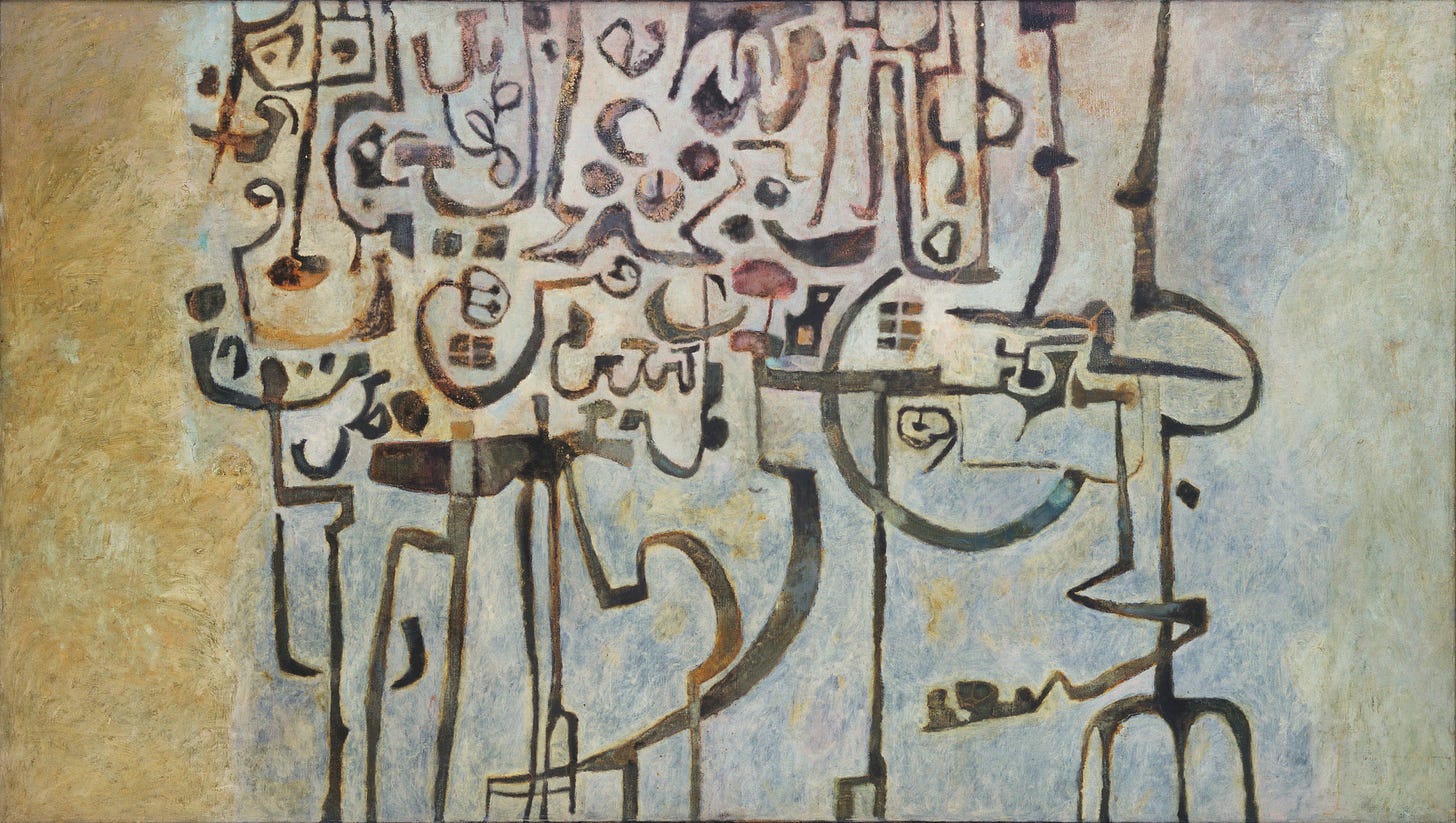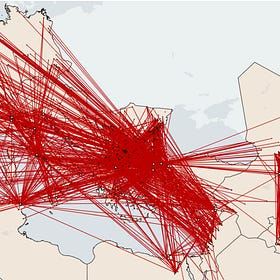Downsizing
The Inheritance of Rome: Illuminating the Dark Ages 400-1000, Chris Wickham, 2009.
As I wrote last time, Henri Pirenne probably got it wrong when he argued that the Arab conquest, not the fall of Rome, defines the history of early mediaeval Europe. Demographic decline, deurbanisation, and falling interregional trade were already in motion, well before the seventh century; and trade in luxuries from East to West continued afterwards. The hinge in the West really was the fifth century.
But the Eastern Mediterranean tells a very different story. There, the collapse of the Western Empire was basically a non-event; while the Arab conquests in the seventh century were epochal. The Eastern Roman (or 'Byzantine’) Empire was plunged into a transformative political and economic crisis via the loss of Egypt, Palestine, and Syria; while those regions, as part of the Caliphate, were made beneficiaries of an empire maybe more ‘Roman’, economically, than any other successor state.
Chris Wickham writes about the East in Framing the Early Middle Ages, and in this, The Inheritance of Rome, published six years later. I did not find the time to talk about it at all, however, when I wrote about Framing: the debates on the origins of feudalism, peasant economies, and the Pirenne thesis were too enthralling, even if largely western in orientation.
Inheritance is broader than Framing in both theme and scope, observing an additional two centuries with a perspective expanded beyond only social and economic history. As a result, while it covers much of the same terrain as its predecessor it includes themes peripheral to Wickham’s narrative in Framing, like discussion of the spiritual world of peasants, Carolingian power, and the consequences of Byzantine iconoclasm.
But Inheritance is perfect for a reorientation eastwards. It is the eastern edge of the Mediterranean where the ‘inheritances’ of Rome are most present. The solidity of the state, the prominence of cities, taxation, and trade; all the main hallmarks of the Roman Empire endured much longer there. But this is not to say there were not changes, especially after the conquests.
The Byzantine Empire was more-or-less unaffected by the collapse of Roman power in the west. While Rome had been supplied with Tunisian grain, and so was sent into sharp demographic decline after North Africa was conquered by the Visigoths, Constantinople was largely supplied by Roman-controlled Sicily and Egypt, and as Rome shrunk, remained monstrously populous. The Empire was confident and relatively prosperous, building immense monuments — the singular Hagia Sophia, for example — and reconquering the most valuable bits of what was the Western Empire (North Africa, Italy, some of Spain) during the mid-sixth century.
But the events between 609 and 642 — multiple wars with Persia which led to the temporary loss of Syria, Palestine, and Egypt; followed soon afterwards by the Arab conquests that made those losses permanent — changed everything. As Wickham says, “the dramatic downsizing and reorganisation of the Empire that resulted was the main break in the imperial history of the East”. The cost was two-thirds of the empire’s land and three-quarters of its wealth1, and the city of Constantinople, cut off from its Egyptian grain, fell from half-a-million to about 50,000 inhabitants in decades (even then it remained the largest city in Europe). Wickham presents archaeological evidence suggesting a sharp fall in intraregional trade. Outside the central cities, such as Constantinople and Thessaloniki, money fell out of use as taxation switched to payments-in-kind. It is quite remarkable that the Empire survived at all; but it did, by the skin of its teeth.
To understand the post-crisis transformation of the Byzantine economy more deeply, Wickham works with the same model that he did in Framing: that “the richer élites were (whether from tax or rents), and the higher aggregate demand was, the more the peasantry was exploited”. The only modification is, as you can see, a more noticeable ‘lumping together’ of fiscal with aristocratic demand. This is perhaps a concession to the view (of which I am sympathetic) that the state mainly stimulated economic activity via redistribution to elites, rather than by administering exchange itself. Wickham tentatively suggests it is likely that a form of aristocratic disempowerment took place, post-crisis, in Byzantium, responsible for the deurbanisation, localisation, and simplification of the economy we observe in the archaeological record.
Wickham is considerably more tentative about this, however, than he is when applying this thesis in a western context. As I have mentioned previously, one of his great strengths is open recognition of the limits in the source material; which are, in this case, particularly severe. There is almost no information about the peasantry or the landed aristocracy of Byzantium until the tenth century. In Inheritance, Wickham relies on the same fragmentary materials that he did in Framing, to get only a glimpse at the rural economy of the era. He does not try to make the comparisons on the same level of detail as he does elsewhere.
From the ninth century Byzantium experienced an economic revival. The “old view”, that the Empire stagnated into the twelfth century is, Wickham writes, “decisively rejected”. Artisanal and agricultural production evidently becomes more specialised and powerful aristocrats and landowners re-enter historical record. The question, however, is whether these elites became as powerful as in the West: was there a ‘feudal revolution’, a transition to the ‘politics of land’, in Byzantium? Wickham doubts this, arguing the evidence suggests that while there was undoubtedly an increase in aristocratic power and wealth, the keys to such a transition were not present. The fiscal system was not under threat, political offices remained more important than land, and Constantinople was undisputedly the nexus of power. Nonetheless, there was a transformation of some degree: tenth century emperors frequently worried about the growing power of aristocrats, seeing them as a threat to the peasant tax-base.
It is because of this transformation, ironically, that the provinces absorbed by the Caliphate wound up retaining the most ‘Roman’ economic features of any polity in the Mediterranean, Unlike the conquerors of the West, Arab armies did not become military aristocracies. The fiscal state was kept intact and the armies remained professional. As a result, Wickham argues, Arab politics were centred around the state and state offices, not landowning. Exchange shifted from a Mediterranean to an Asiatic orientation, but remained high by relative standards. It is unsurprising, therefore, that these provinces do not appear to be markedly poorer post-conquest, unlike those left under Byzantine rule.
This brings us to Egypt: not only perhaps the most important province in the Mediterranean during this entire period, but one which exhibited remarkable continuity. That strip of civilisation on the Nile had been the richest province of the Roman Empire by far, and the most complex. It remained this way, according to Wickham, until the fourteenth century. The hub of Mediterranean exchange, and the access point to the Indian Ocean, Egypt was “the motor that ran the entire medieval trade cycle”.
In an era of sparse documentation, Egypt is also remarkable for how much we can know about it. Tax records, as well as legal documents, correspondences, and commercial records: the breadth and completeness of what has survived is incredible. This is attributable to the solidity of the state and to the climate of the region, where papyrus and paper records are preserved in dry deserts. There are also the ‘wastepaper’ collections of pious mediaeval Egyptian Jews, who preserved countless documents, if in a rather unsystematic fashion, due to a belief that anything with God’s name written on it was sacred.2
The central point Wickham wishes to make about Egypt’s internal economy is that the weakening, and later renewal, of aristocratic power which frames the early middle ages from Britain to Anatolia was much less pronounced there. It was always the case that elite power was relatively weak in Egypt, where rural society was organised, on a village level, around rich peasants who directly interacted with the state via the taxation system . The Arab conquest pushed out the few real magnates, and so only strengthened this fiscal system. While the traditional narrative about the mediaeval Islamic world stresses a degradation of this system over time, with tax-collectors morphing into landowners, there is little evidence of this happening in Egypt before the millennium. It was, and remained, perhaps the most extraordinary place in the Mediterranean.
In both Inheritance and Framing, Wickham does tie himself in knots over the question of ‘fiscal vs commercial’ exchange in the East, just as I discussed for the West last time. But he does so less often, and less severely. In fact, a shift in emphasis between the two books is noticeable. As I noted above, when he talks about the state it is largely in the context of how it channelled demand; not, as he often did in Framing, how exchange itself was administered by the Roman state. The emphasis on aristocratic demand is now the “main motor”, not one of two, and what Wickham now calls the “caging of the peasantry” in the late-early middle ages is unambiguously the central story of his thesis. It makes Inheritance feel more cohesive, refined, and correct than Framing did.
Specific mechanisms of historical change aside, Wickham’s elemental point in both these two big books is that the paths taken from the fall of Rome and the Arab conquests, to high feudalism and the rise of the North, are messy and difficult to narrate. I have discussed his rejection of an Andersonian genealogy of feudalism and the Pirenne Thesis in previous reviews. Now, while I have left it implicit, the same pattern holds. By declaring the inheritance of Rome for the Caliphate, and emphasising Byzantine strength and revival, Wickham makes it harder to view Byzantium as a stagnant empire on life support, or the Islamic world as fundamentally alienated from the history of economic development. This committed stance against teleology, while certainly less fun than the elegant tales of Marxist Theorists and New Institutionalists, and sometimes less insightful, is what makes historians like Wickham necessary. It keeps us all sober.
Supplemental: Downsizing
Reading Wickham write about the Pirenne Thesis in both Framing the Early Middle Ages and The Inheritance of Rome, I recalled this paper which did the rounds on twitter some time ago, “Trade and the e…
I haven’t looked into this estimate — Wickham attributes it to Michael Hendy. It seems about right, but I have taken it with a grain of salt.
These troves are not an exclusively Egyptian phenomenon, but they seem to be particularly rich there, due in part to Egypt’s economic importance. I will be writing about them again (and again!), don’t worry.




I lean towards a military determinist view of early medieval social transformation:
Regions of discontinuity:
Byzantium: Constant Arab raids in Anatolia, Slavs overrun the Balkans. Some social continuity maintained through Constantinople
Italy: Devastated by the Gothic Wars, then conquered by Lombards
Northern Spain: After Moorish conquest of the south, turned into a military frontier like Anatolia
France: First stop for every barbarian group crossing the Rhine
Britain: Chaos after Rome withdraws, then invaded by Anglo-Saxons
Meanwhile, in the Caliphate:
Swift and final conquest, political unity across a large area, protracted fighting shifted outside its borders
Peace and security enable social and economic complexity. Absent peace and security, you lose complexity, including the kind necessary to.cage the peasantry.